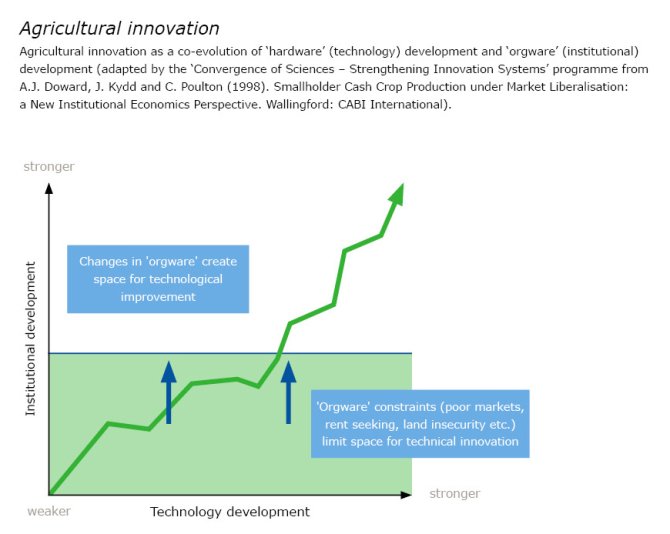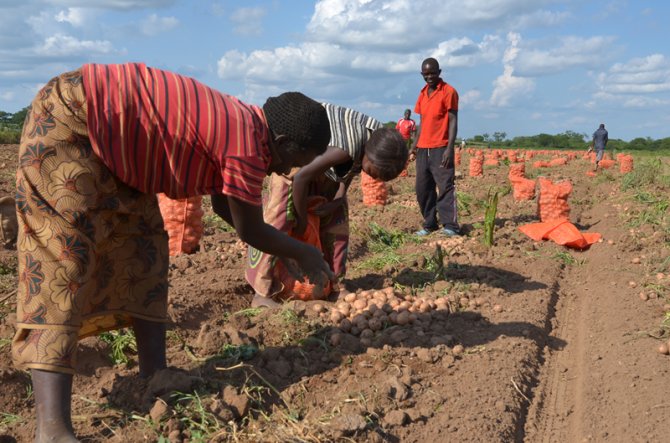Agricultural innovation - more than technology alone
Innovation is often associated with technological improvements. Cees Leeuwis, professor of knowledge technology and innovation looks beyond the hardware, and points out that new technology only works when it fits within a shared way of thinking and future vision (software) and is supported by new rules and organisational structures (orgware). “There will be no innovation if the software and orgware do not co-evolve together. Innovation has to be grounded and rooted in society, where the actual changes take place."
"Problems with food security are often related to orgware issues. Technologies to improve soil fertility – for example by means of artificial fertiliser or crop rotation – assume that farmers can and wish to invest in the land. Poverty always plays a role in preventing investment, as does the way access to the agricultural land is organised. In Africa, for instance, a lot of land is leased via short-term agreements or borrowed from family. The resulting insecurity makes investing in the land a tricky issue. If I didn’t know whether I would be able to reap what I’d sown, I wouldn’t invest my money either. In this case, yield gaps aren’t soil problems but an issue of land rights. Improving soil fertility can only be achieved by experimenting with alternative lease or tenancy contracts that are based on a longer time span, including associated systems for settling disputes. If that is unsuccessful, one could consider optimising production systems in the short term.”
In Africa, a lot of land is leased via short-term agreements or borrowed from family
“Improving food security therefore not only requires investments in the development of technology, but also in the processes required to develop new shared future visions and orgware. We must remember that our own, much renowned high-productive agriculture was partly developed as a result of far-reaching land reforms, subsidies, import limitations and a strong focus on collaboration within the sector. It is a misconception to think that development can be stimulated by simply transferring or exporting our knowledge and technology. It revolves around new ways of organising and coordinating people.”

Mouldable world
“Another persistent misconception is the idea that innovation and development can be planned and predicted. The idea that we live in a mouldable world. This is reflected in the way we traditionally organise and evaluate development projects. Most programmes are still characterised by clear-cut goals, detailed step-by-step plans and evaluation protocols that are focused on simple cause-and-effect relations. The reality is far more complex. The world consists of intricate social and biophysical systems and networks that influence each other via countless interactions. This leads to unpredictable dynamics with often unintended consequences.”
“Stimulating food security requires organising a process of continuous adaptation to new conditions instead of linear projects. Additionally, history has shown that innovation involves a competitive and evolutionary process in which multiple options and futures compete in a selection environment and the ‘best fitting’ wins. This is not necessarily the most advanced option technologically. It may also be the option that best suits the socio-economic conditions. Most potato farmers in East Africa, for example, cannot afford new pathogen-free seed potatoes due to the level of investment required. It seems a better option therefore to improve the selection of their own seed potatoes. A simple solution, but one that escaped attention for a long time because it was seen as outdated technology.”

Multiple options
“Although existing knowledge and technology can fail to any longer meet a given transitional context, that does not mean we should dismiss them as outdated. From the perspective of adaptation it is often wise to back multiple options. It is important that we organise people around a variety of technical and socio-organisational experiments; not in a laboratory but at various levels in daily practice. This means bringing people and disciplines together, studying the environment, clarifying questions, developing visions and learning what happens in these experiments. Well-trained innovation intermediaries – brokers and links between people and expertise, as it were – can support these processes. Experience has taught us that these professionals can make an important contribution, and luckily this is recognised by many. There are now many experiments with innovation networks and R4D (research for development) platforms, and this creates a wealth of opportunities for scientists to become involved in transition processes and increase the chance of having a positive impact."